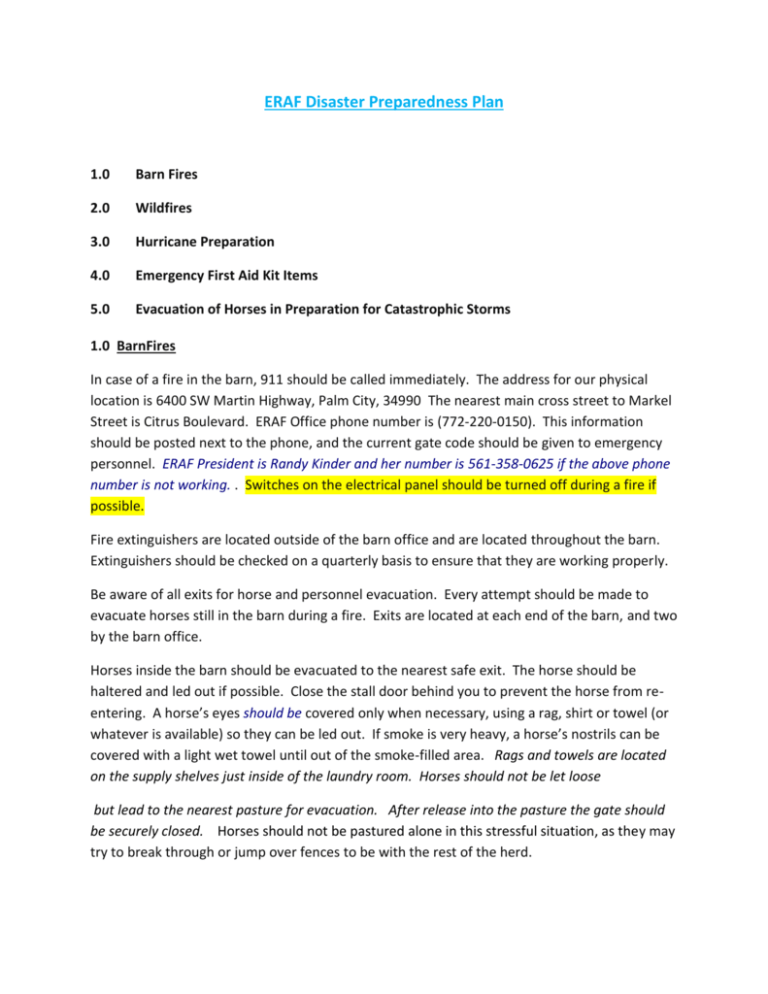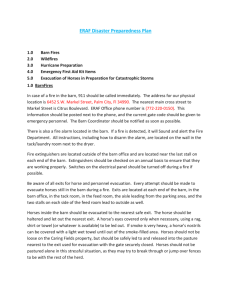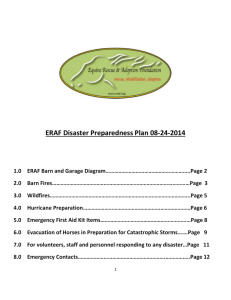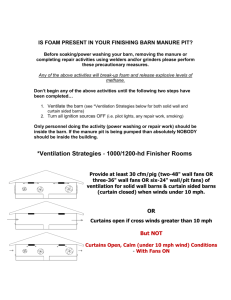ERAF Disaster Preparedness Plan
advertisement

ERAF Disaster Preparedness Plan 1.0 Barn Fires 2.0 Wildfires 3.0 Hurricane Preparation 4.0 Emergency First Aid Kit Items 5.0 Evacuation of Horses in Preparation for Catastrophic Storms 1.0 BarnFires In case of a fire in the barn, 911 should be called immediately. The address for our physical location is 6400 SW Martin Highway, Palm City, 34990 The nearest main cross street to Markel Street is Citrus Boulevard. ERAF Office phone number is (772-220-0150). This information should be posted next to the phone, and the current gate code should be given to emergency personnel. ERAF President is Randy Kinder and her number is 561-358-0625 if the above phone number is not working. . Switches on the electrical panel should be turned off during a fire if possible. Fire extinguishers are located outside of the barn office and are located throughout the barn. Extinguishers should be checked on a quarterly basis to ensure that they are working properly. Be aware of all exits for horse and personnel evacuation. Every attempt should be made to evacuate horses still in the barn during a fire. Exits are located at each end of the barn, and two by the barn office. Horses inside the barn should be evacuated to the nearest safe exit. The horse should be haltered and led out if possible. Close the stall door behind you to prevent the horse from reentering. A horse’s eyes should be covered only when necessary, using a rag, shirt or towel (or whatever is available) so they can be led out. If smoke is very heavy, a horse’s nostrils can be covered with a light wet towel until out of the smoke-filled area. Rags and towels are located on the supply shelves just inside of the laundry room. Horses should not be let loose but lead to the nearest pasture for evacuation. After release into the pasture the gate should be securely closed. Horses should not be pastured alone in this stressful situation, as they may try to break through or jump over fences to be with the rest of the herd. The barn cats will most likely be able to escape the barn on their own during a fire. No one should place themselves in a dangerous situation in an attempt to look for the cats. 2.0 Wildfires Wildfires in the area should be closely monitored by barn personnel. If a fire is approaching the area, preparations for evacuating the horses should be planned well in advance. ID tags should be placed on each horse and all Coggins records, medical records and other vital information will be transported with each horse to the evacuation area. The ID tags for each horse along with its medical records is located in the office. ERAF’s evacuation area is a location to be determined by the Barn Coordinator and Board of Directors immediately following a declared disaster. It will be emailed to all listed as a volunteer or staff within the ERAF organization. It will also be posted at the gate. At least a 3 day supply of grain, hay, supplements and medications should accompany evacuating horses to the evacuation area. Feed and water buckets should also be taken. Other staff members and all Board members should be notified if a wildfire evacuation becomes necessary. If the barn cats must be evacuated, they will be kept at a location to be determined. 3.0 Hurricane Preparation Preparations should be made well in advance of a storm, preferably at the beginning of a hurricane season. The Board of Directors and the Barn Coordinator are responsible for the disaster preparations. Check generator and gas supply a. Prepare to keep a two to three week supply of hay, grain, supplements, medications and cat food. These items can be stored at the Ed Center. b. Check for adequate fresh water storage, including frozen soda/water bottles filled with water to keep refrigerator cool in the case of power outage. Our old water tubs should be filled and used as drinking water for the horses and barn cats. 12 – 18 gallons of water per horse per day should be stored for drinking c. Check supply of heavy duty trash bags, flashlights, battery operated lanterns, hand sanitizer and baby wipes. d. e. Check boarding for windows in office and tack room. Check equipment storage in preparation for storm (including take down of the round pen) f. Prepare horse identification – tags, livestock markers on horses and halters. g. Photographs or video of property and animals should be taken in advance of a storm and securely stored for insurance and identification purposes. h. Horse records and other important documents should be copied and stored in a plastic container. These records should be moved to a secure location just before the storm (i.e. Ed Center). i. Store and secure items that could become debris and projectiles during strong winds. j. Have an adequate supply of chlorine bleach to treat contaminated water. k. Fire extinguishers and fire alarm systems should be checked and tested. l. Prepare to turn off the electricity to the barn and turn off the supply to the electric fences. Circuit Breakers are located in the Tack/Laundry Room. m. Have emergency first aid kit prepared and on-hand. The kit should be stored in a secure location during the storm. n. Fences should be checked and repairs made before the storm if horses will be turned out during hurricane conditions. o. Put breakaway halter on each horse with ID tag. No nylon halters during the storm! 4.0 Emergency First Aid Kit Items Any current medications for each horse Medications that may be needed Syringes or needles required to administer medication Ointments for wounds Hydrogen peroxide Bandages and wraps Medical Towels Scissors Medical tape At least two thermometers Flashlights with fresh batteries Hoof Knife Sterile gauze pads Vetwrap Additional halters and lead ropes Cotton-tipped swabs Hand-Sanitizing towels Eye flush and ointment Insect repellent Furazone Blue Kote spray Horseman’s Dream Cream Anything else we can think of for minor physical ailments or conditions 5.0 Evacuation of Horses in Preparation for Catastrophic Storms Eraf has been listed on the Sunshine State Horse Council, Inc. (www.SSHC.org) as a shelter during storms. Yes, ERAF is Currently Listed on WWW.SSHC.Org, But information needs to be checked and updated, if necessary. An evacuation decision will be determined by the Barn Coordinator and members of the Board of Directors. In all probability, horses will remain at the ERAF barns during storms. The barn is well-constructed and has adequately weathered numerous hurricanes. Many of ERAF’s horses with health and physical problems would not be able to make a long trip in a horse trailer. Horses remaining at the barn for the duration of the storm will be kept inside for storms in Categories 1 – 3. Horses will be turned out to pasture for Category 4 and 5 storms if the decision is made not to evacuate. Each horse must be wearing a breakaway halter during hurricane conditions. Evacuation factors to be considered will be intensity and anticipated location of landfall and conditions associated with the storm. Locations in north and south Florida, as well as locations out of state are available to be considered. Stable locations for disaster evacuations are available in Georgia and south Carolina, with specific information on these locations on file. Evacuation routes will be discussed when location is determined. In the case of a decision to evacuate, horses that are able to physically make the trip will be transported by ERAF trailer and trailers owned and operated by ERAF members at least 72 hours before anticipated hurricane conditions. Rescue horses that are not physically able to make a long trip will be relocated to more stable and secure structures in the immediate area until the storm passes (Martin Downs). All coggins records, medical records and other vital information will be transported with each horse. Sufficiient supplies of feed, water, buckets and necessary medications will also be transported. Barn cats will remain at the barn unless it is determined that the structure of the barn will not withstand the anticipated winds. If the cats must be evacuated, they will be kept at a location to be determined. Emergency animal transport services in the area and Emergency Management contacts for Martin County are attached. This information can also be found at www.flsart.org. More disaster preparedness information can be found at WWW.floridadisaster.org. For all volunteers, staff and personnel responding to a disaster at ERAF you must bring all food, drinks, clothing, bug spray, bedding, toiletries and medication for yourself. It is important that you assume that there is nothing being furnished for you. If you respond plan at least for two or three days for all of these items. If you have a working phone you are advised to Call the Barn Manager or a Board member to find out where to meet if the road to the barn is blocked. There will be vehicles available to get you to the barn from a cental meeting area to be determined according to the disaster declared. Emergency Management Agency Staff 2013 EMA Director: Debra McCaughey (772) 219 4942 Deputy EMA Director/Rep Administrator: Chris Church (772) 463-2852 PlannerII/Special Needs Program: Carol Dryburgh (772) 419-2664 Administrative Specialist: (772) 219-4941 Emergency Public Information Line: (772) 287-1652 Emergency Management Fax: (772) 286-7626 Florida Disaster Prepare and Stay Aware List Water: at least 1 gallon daily per person for 3 to 7 days Food: at least enough for 3 to 7 days Non –perishable packaged or canned food/juice Snack foods Non-electric can opener Cooking tools/fuel Paper plates/plastic utensils Blankets / Pillows, etc. Clothing: seasonal/rain gear/sturdy shoes First Aid Kit/ Medicines / Prescription Drugs Special Items: Toiletries – hygiene items Moisture Wipes Flashlight / Batteries Radio – Battery operated and NOAA weather radio Cash – Banks and ATMs may not be open or available for extended periods. Keys Books / Games Important Documents – in a waterproof container Tools – Keep a set with you during the storm Vehicle fuel tanks filled









